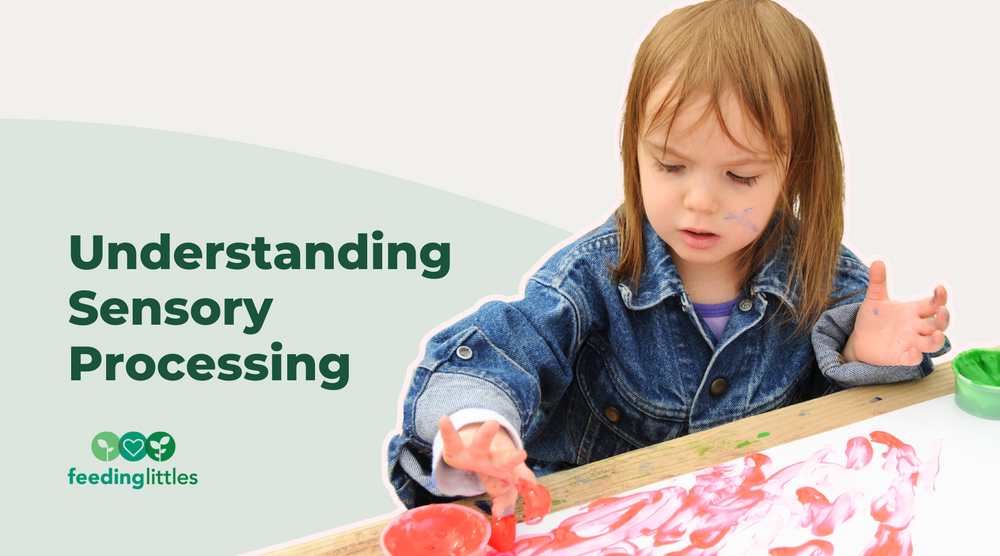
Let’s talk sensory processing! This is a big topic, but we wanted to give you some basic information so that you can understand your child’s needs and development a little better.
In short, your child’s sensory system dramatically impacts how they perceive the world, how they learn, and even how they eat. When it’s functioning as expected, you may not even think about sensory processing. However, when sensory integration goes awry, it can affect many facets of your child’s life.
We want to share with you some background regarding sensory integration so you can understand why your child may react to certain sensory inputs, how to best support your child’s sensory system, and how to know if your child needs help with sensory processing.

Sensory integration/processing helps people “make sense” of the world around them.
Think of all the sensations you experience while dressing, bathing, walking or even driving a car to the airport.
Sensory Integration is the process of using our senses to:
- Quickly take in sensory information.
- Organize this information.
- Use it for success in everyday activities.
We usually think of five senses: sight, sound, taste, touch (tactile), and smell.
We also receive information from our body position sense known as proprioception, and balance and movement sense known as vestibular sense.
Touch sense – tactile
The tactile sense gives us information from our skin, including inside and outside our mouths. Every time you touch something or you are touched, your skin provides you with detailed information; this comes from the tactile sense. It allows you to tell the difference between a friendly touch versus the uncomfortable feeling of a bug biting you on the arm.
Think of a child licking ice cream from a cone as it drips down their arm. Does the child continue eating the ice cream and lick off the drips, or is the child completely bothered by the drips, drops the cone, and becomes very upset? This is the tactile system hard at work, it is either seen as pleasurable or averse. As you can imagine, when a child perceives certain tactile sensations as “bad,” it can dramatically affect their success with feeding, playing and learning.
Body position sense – proprioception
Proprioception is our body’s position sense. Proprioception is the ability to know where a body part is without having to look, and it helps us know how much pressure we need to do certain things. We use this sense when we pick up a paper cup filled with water without spilling or holding it too tightly.
For example, have you ever watched your child pull a wheeling suitcase or push a play shopping cart around the house and then change the weight of the suitcase or cart? Their proprioception changes when they realize they must push or pull the object harder. This sense is automatic and happens without much conscious thought, and it is a result of their proprioceptors hard at work within their joints. Pretty cool, right?
Movement/gravity sense – vestibular
The vestibular system is our balance and movement sense. The vestibular sense allows us to move smoothly and balance while engaged in activities. We use this sense when riding a skateboard or sliding down a slide at the playground.
Watch a toddler as they practice their balance on uneven surfaces at the park. They may struggle at first, but it usually improves with each trial.
When our senses unite
Integrating and processing information from the tactile, proprioceptive, and vestibular systems, along with the other senses (sight, sounds, taste and smell), makes it possible to successfully participate in everyday activities.
For example, visualize a six-year-old holding a baseball bat and trying to hit at a T-ball. The tactile (touch) sense helps them hold the bat correctly. Proprioception (body) sense helps them know their body is in the correct position. Vestibular (balance and movement) sense helps them stay upright while swinging the bat. Their vision (sight) and hearing (sound) are also key to his success in the game.
Our bodies are truly amazing when they work as expected. However, what happens when things don’t work automatically?
Some kids struggle with sensory integration, which can affect their success with feeding. These behaviors may include:
- Overly sensitive or under reactive to touch, movement, sights, or sounds in the environment.
- Unusually high or low activity level.
- Easily distracted/poor attention to tasks.
- Delays in oral motor skills, feeding skills, excessive pickiness and unexplained food refusals.
- Delays in speech, motor skills or academic achievement.
- Coordination problems – appears clumsy or awkward.
- Poor body awareness – frequent bumps and bruises (beyond the average kiddo).
- Difficult learning new tasks or figuring out how to play with unfamiliar toys.
- Appears to be disorganized most of the time.
- Difficulty with transitions between activities or environments.
- Immature social skills for age.
- Impulsivity or lack of self-control.
- Difficulty calming self once “wound up.”
If you notice any of the above behaviors, which may affect your child’s home or school environment, talk to your healthcare provider. Ask to be scheduled for a full assessment that includes a Sensory Processing Evaluation. Therapists trained in Sensory Integration utilize a play-based, child-friendly approach.
We know therapy sounds overwhelming, but it can really help. In this setting, children improve their ability to process and organize sensory information while engaging in a variety of fun sensory experiences. Therapy can help kids simply be kids, playing alongside friends, and fully enjoying their young lives while learning to respond to a sensory-rich world.
Want to help support and develop your child’s sensory system? Utilize the following activities on a regular basis, and make sure to never pressure a child to do something they’re not ready for yet (e.g. touch a texture they’re averse to).
- Swings, climbing structures, big pillows and bolsters can help vestibular input and deep proprioceptive input.
- Moon/kinetic sand, shaving cream, Play Doh and messy squishy toys (slime, water beads) can help with tactile development. Furthermore, touching and exploring food, especially in infancy and toddlerhood, is a wonderful tactile and general sensory experience.
- Balance beams, mini trampolines or climbing walls can help with balance and movement skills.
- Pushing a weighted laundry cart or tossing weighted bean bags at a target can help develop proprioception skills. A weighted blanket or weighted stuffed animals are great to help calm kids down too.
- If you’d like, introduce a fidget toy! Fidget toys are actually recommended to calm kiddos down and get their focus onto a simple movement or tactile activity. Great fidget toys include: “Bug Out Bob”, OOZE Tubes, Stress Balls, Bendy Man, Stretchy Mice Cheese, Stress Less Gel Ball, and Tactile Atom ball, all available through www.got-specialkids.com.
We wish you fun and playfulness on your sensory development journey!
